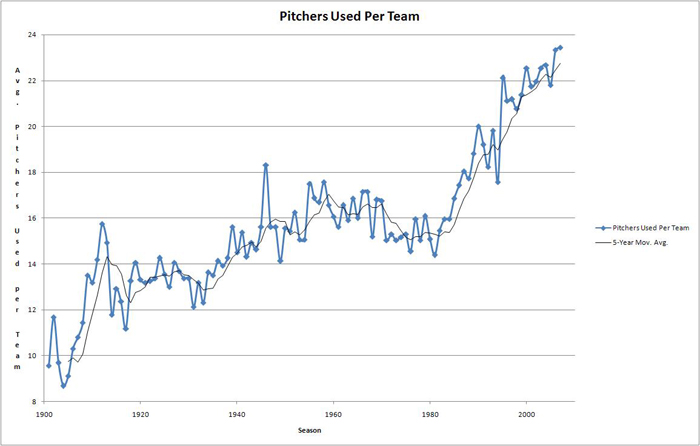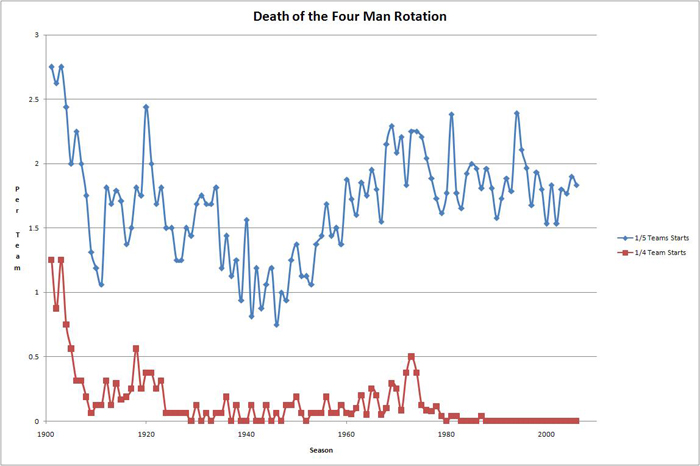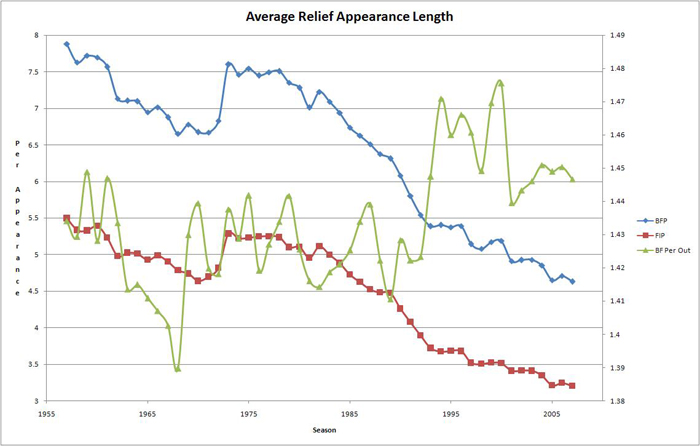BP Comment Quick Links

 | |
September 12, 2007 The Big PictureNever Enough Pitching?
The increase in scoring over the last fifteen years is taken as a sign of the decline in the quality of pitchers, either through a lack of ability or a dilution of talent. As pitching has declined, however, the number of pitchers used has increased. Does this make sense, or is this a logical contradiction? If a team's roster consists of ten people pitching poorly, why would adding an eleventh or twelfth arm improve things? To be clear, roster management changed to add pitchers rather than look for the best nine or ten pitchers to carry on a team. Why did this strategy develop? Roster turnover, particularly on the pitching side of the roster, is at its highest in the history of the two-league system. With over two weeks to go in the 2007 season, the majors set a new high in pitchers used per team:
 If teams are normally carrying twelve pitchers, they're almost completely turning over the roster during the season. While the long-term trend of the graph points upward, there are two dips in the chart that are of interest. The first took place in the early 1930s, the other in the 1970s. These are two very different eras in baseball. Offense exploded in the 1930s, much as it did in the 1990s. Even so, the number of pitchers used didn't increase. That's likely due to the changes going on in the minor leagues at the time. Branch Rickey developed the modern conception of the farm system, and the Cardinals (and other rich teams) horded players, making fewer good ones available to other teams. On top of that, the Depression meant that teams had less money to spend, and limited the number of players they paid. The 1970s saw a trend toward specialization. The following chart shows the number of pitchers per team who started at least five games and relieved at least five games:
 In the 1950s, the majority of pitchers on a team were called on to perform both roles. That number dropped steadily during the 1960s, resulting in teams using fairly set rotations during the early 1970s. Most pitchers before the 1960s were used not in a specific role, but rather as the manager saw fit; they could start or work out of the bullpen, depending on the needs of the team. You can see the switch from flexible staffs to defined roles in the following graph:
 The blue line represents the number of pitchers per team starting at least one fifth of the scheduled games, which is what you would expect from a perfect five-man rotation. The red line represents the number of pitchers starting one quarter of the scheduled games, which would be a four-man rotation. As you can see from the blue line, between the end of the fifties and start of the seventies, more pitchers moved into the role of full-time starters, as more players started over a fifth of the teams' games. Rather than requiring a staff that could start and relieve as needed, a set number of starters meant relievers in general would work less. Thus, fewer pitchers were needed. You can also see from the red line just how tough it is to maintain a four-man rotation, even for one pitcher on a team. I'm as guilty of this as anyone, but we tend to think that pitchers used to go out every fourth day and throw nine innings, not needing to be babied. That's just not true. A 154-game season was a grind, and a 162-game season is even worse. Look how the number of pitchers able to start a fifth of their teams' games peaks in the strike years of 1981 and 1994; they didn't have a chance to wear down. There was a brief period in the 1970s when teams tried to get forty starts a year out of pitchers, but after 1976, that player usage pattern had lost popularity. By the late 1980s, no one started one quarter of his team's scheduled games any more. Again, 1976 appears as an inflection point, as the value of players changed with the adoption of free agency. Teams could no longer just worry about this season; a long-term contract meant they needed to make sure a hurler lasted the appropriate number of seasons, and with young pitchers tied to them for "only" six years, there was reason to keep that cheap talent healthy as well. The pitchers also realized their new value and wanted to protect themselves. As time went on, starters complained about pitching too often or too long in a game. Over time, relievers also pitched less and less; with individual game lines going back to 1957, we can study the average length of a relief appearance in terms of both batters faced and outs recorded (FIP, fractional innings pitched):
 The decline in the length of relief appearances starts in 1982, and has continued unabated ever since. Pitchers coming out of the bullpen today face about 2.5 fewer batters and record two fewer outs than they did a quarter of a century ago. With starters pitching less often and with generally shorter outings, someone needs to record the outs, so more and more pitchers are needed on the active roster. By limiting the amount both starters and relievers throw, teams created a demand for more pitchers, but those pitchers are of lower quality. The green line represents the number of batters faced by a reliever needed to get one out. It jumps in 1993 with expansion; at the time, dilution of pitching was blamed, but there was a double whammy. Teams already diluted pitching staffs, giving more innings to second-tier pitchers. Expansion just flooded the game more, which is big factor in the offensive explosion of the 1990s. Teams added pitchers because the limits placed on starters and the specialization of relievers required them to use more pitchers per game. It seems once teams started down the road to specialization, there was no turning back, but there's little evidence that the defining of precise roles and limits placed on relievers did much to limit offense. A staff consisting mostly of pitchers who could start and relieve might give managers more flexibility in matching up to pitchers' strengths with certain opponents or to certain stadiums. Instead, while waiting to see if a demand for more flexibility with position players develops, roster slots keep going to the pitching staff, bringing us to our current point, where frequently the only players on an American League bench are the club's lone backup catcher, the one backup infielder, and a single reserve outfielder.
|